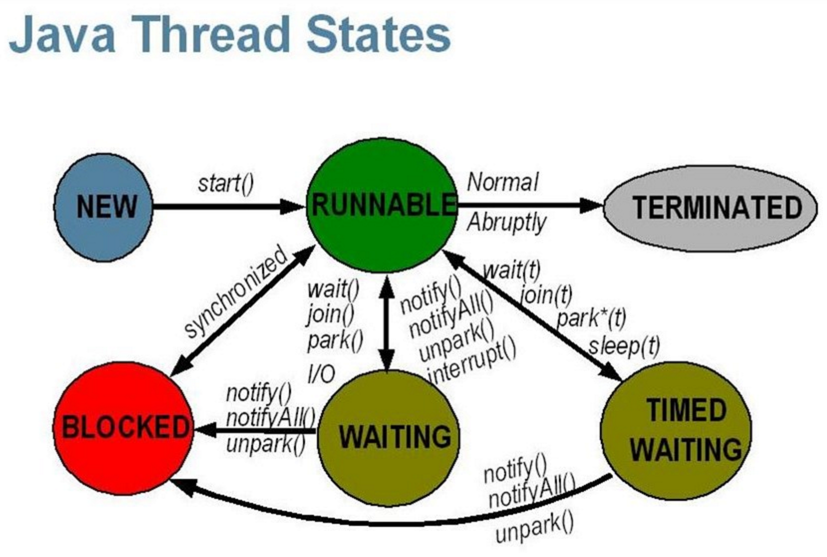线程状态
(1)NEW(新建尚未运行/启动)
还没调用start,或者调用了start()方法,不一定立即改变线程状态,中间可能需要一些步骤才完成一个线程的启动。
(2)RUNNABLE(处于可运行状态:正在运行或准备运行)
start调用结束,线程由NEW变成RUNNABLE,存活着,并尝试占用CPU资源,yield操作时,线程还是Runnable状态,只是它有一个细节的内部变化,做一个简单的让步。在Java层面是Runnable的状态,并不代表一定处于运行中的状态,比如BIO中,线程正阻塞在网络等待的时候,看到的状态依然是Runnable状态,而底层线程已经被阻塞住了。
(3)BLOCKED(等待获取锁时进入的状态)
线程被挂起了,原因通常是因为它在等待一个锁,当某个synchronized正好有线程在使用时,一个线程尝试进入这个临界区,就会被阻塞,直到另一个线程走完临界区或发生了相应锁对象的wait操作后,它才有机会去争夺进入临界区的权利。当抢到锁之后,才会从blocked状态恢复到runnable状态。这个状态它好像什么也不做一样。
(4)WAITING(通过wait方法进入的等待)
当wait,join,park方法调用时,进入waiting状态。前提是这个线程已经拥有锁了。
blocked和waiting状态的区别是:
A、blocked是虚拟机认为程序还不能进入某个区域,因为同时进去就会有问题,这是一块临界区。
B、发生wait等操作的先决条件是要进入临界区,也就是线程已经拿到锁了,自己可能进去做了一些事情,但此时通过判定业务上的参数,发现还有一些其他配合的资源没有准备充分,那么自己就等等再做其他事情。
在waiting状态下,如果发生了interrupt操作,则处于该状态的线程在内部会抛出一个InterruptedException,这个异常应当在run方法内捕获,使得run方法正常地执行完成,当然捕获异常后,是决定让线程继续运行,还是结束等要根据业务场景才处理。
如果发生了notify动作,则会从等待池当中唤醒一个线程重新恢复到Runnable状态,如果是notifyall操作,则唤醒所有等待线程。
(5)TIMED_WAITING(通过sleep或wait timeout方法进入的限期等待的状态)
通过wait(t),sleep(t),join(t),parkNanos,parkUntil等方法进入此状态。当时间达到时触发线程回到工作状态Runnable。
interrupt只对处于waiting或timed_waiting状态的线程起作用,对其他状态不起作用。
(6)TERMINATED(线程终止状态)
线程结束了,就处于这种状态,也就是run方法运行完了。这只是Java语言级别的一种状态,在操作系统内部可能已经注销了相应的线程,或者将它复用给其他需要使用线程的请求。
线程状态切换
详细图
线程状态源码
/**
* A thread state. A thread can be in one of the following states:
* <ul>
* <li>{@link #NEW}<br>
* A thread that has not yet started is in this state.
* </li>
* <li>{@link #RUNNABLE}<br>
* A thread executing in the Java virtual machine is in this state.
* </li>
* <li>{@link #BLOCKED}<br>
* A thread that is blocked waiting for a monitor lock
* is in this state.
* </li>
* <li>{@link #WAITING}<br>
* A thread that is waiting indefinitely for another thread to
* perform a particular action is in this state.
* </li>
* <li>{@link #TIMED_WAITING}<br>
* A thread that is waiting for another thread to perform an action
* for up to a specified waiting time is in this state.
* </li>
* <li>{@link #TERMINATED}<br>
* A thread that has exited is in this state.
* </li>
* </ul>
*
* <p>
* A thread can be in only one state at a given point in time.
* These states are virtual machine states which do not reflect
* any operating system thread states.
*
* @since 1.5
* @see #getState
*/
public enum State {
/**
* Thread state for a thread which has not yet started.
*/
NEW,
/**
* Thread state for a runnable thread. A thread in the runnable
* state is executing in the Java virtual machine but it may
* be waiting for other resources from the operating system
* such as processor.
*/
RUNNABLE,
/**
* Thread state for a thread blocked waiting for a monitor lock.
* A thread in the blocked state is waiting for a monitor lock
* to enter a synchronized block/method or
* reenter a synchronized block/method after calling
* {@link Object#wait() Object.wait}.
*/
BLOCKED,
/**
* Thread state for a waiting thread.
* A thread is in the waiting state due to calling one of the
* following methods:
* <ul>
* <li>{@link Object#wait() Object.wait} with no timeout</li>
* <li>{@link #join() Thread.join} with no timeout</li>
* <li>{@link LockSupport#park() LockSupport.park}</li>
* </ul>
*
* <p>A thread in the waiting state is waiting for another thread to
* perform a particular action.
*
* For example, a thread that has called <tt>Object.wait()</tt>
* on an object is waiting for another thread to call
* <tt>Object.notify()</tt> or <tt>Object.notifyAll()</tt> on
* that object. A thread that has called <tt>Thread.join()</tt>
* is waiting for a specified thread to terminate.
*/
WAITING,
/**
* Thread state for a waiting thread with a specified waiting time.
* A thread is in the timed waiting state due to calling one of
* the following methods with a specified positive waiting time:
* <ul>
* <li>{@link #sleep Thread.sleep}</li>
* <li>{@link Object#wait(long) Object.wait} with timeout</li>
* <li>{@link #join(long) Thread.join} with timeout</li>
* <li>{@link LockSupport#parkNanos LockSupport.parkNanos}</li>
* <li>{@link LockSupport#parkUntil LockSupport.parkUntil}</li>
* </ul>
*/
TIMED_WAITING,
/**
* Thread state for a terminated thread.
* The thread has completed execution.
*/
TERMINATED;
}

**粗体** _斜体_ [链接](http://example.com) `代码` - 列表 > 引用。你还可以使用@来通知其他用户。